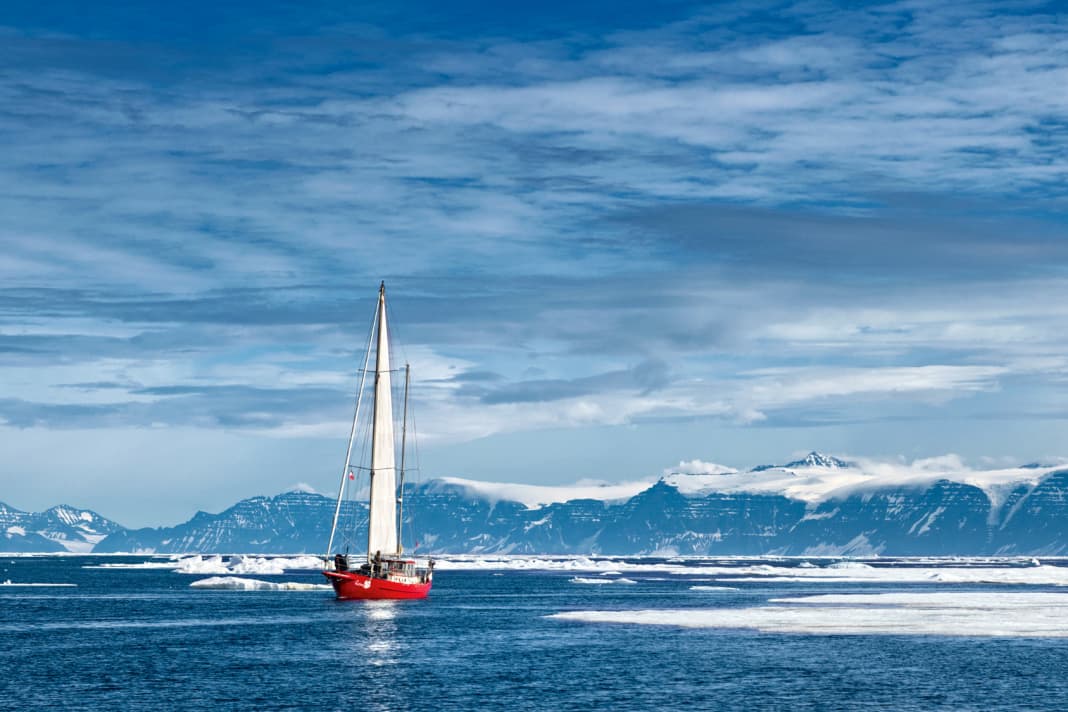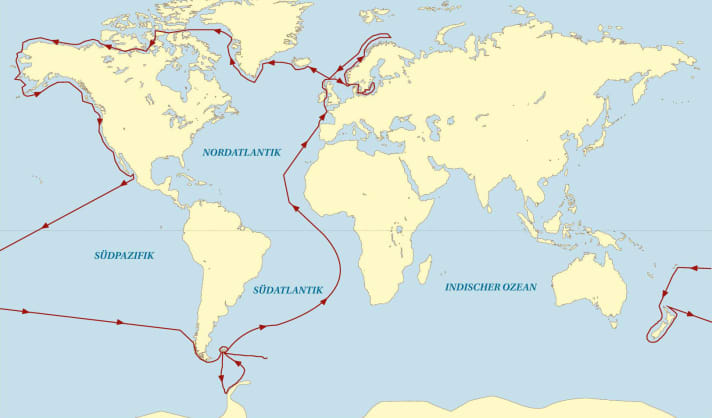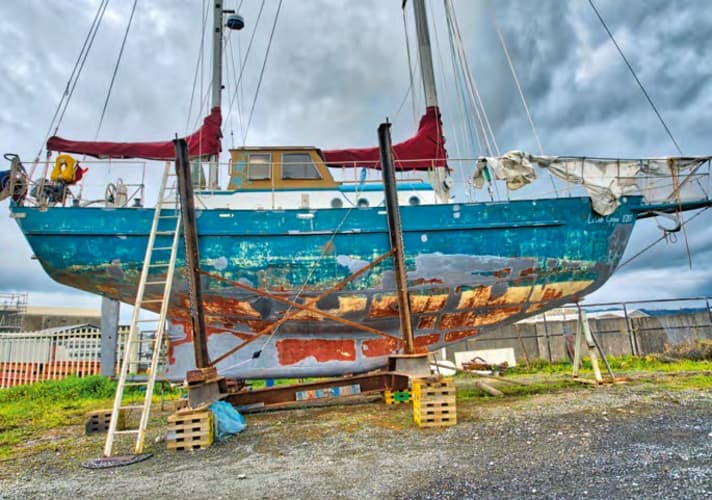Claudia and Jürgen Kirchberger: With sailing yacht and motorbike to Greenland
Kristina Müller
· 26.01.2023






The allure of the extreme repeatedly draws the Kirchbergers to areas that are far beyond any comfort zone. They have spent the winter in Norway and Greenland, crossed the Northwest Passage, explored Patagonia and sailed to Antarctica. The steel ketch "La Belle Époque" was their home for ten years before they returned to Austria in 2019. Then a new adventure beckoned: with light off-road motorbikes on board, they set off for Greenland again in the summer of 2022. In this interview, the pair talk about their new passion, long-distance travelling as a lifestyle and why they are so much more attracted to the high latitudes than the barefoot route.
YACHT: After two years of living on land, you sailed to Greenland and back this summer. Was that the start of a new big trip?
Jürgen Kirchberger: It was mainly a test cruise. We did a big refit last year: shaft, propeller, sails and we also changed the rig. After that, we wanted to sail comfortably around the Baltic Sea to Haparanda to see if everything would work out for future trips. Then came the Ukraine war. We decided that we would rather set course for East Greenland.
With motorbikes on board! How did they get into the game?
Jürgen: Two years ago, we were travelling off-road on snowmobiles in Canada. We thought that would also be something for Austria, but it's not that easy there. However, motocross bikes come pretty close. In the end, we ended up with small and light so-called trials.
Claudia: I already had the idea in the back of my mind: they're small enough for the boat too! We have a forward cabin that we don't actually use. They fit in through the hatch if you take them apart a bit. When we loaded them for the first time, we checked to see if this would affect the waterline. But "La Belle" doesn't even notice it!
Jürgen: As a sailor, you always see a lot of the coast, but for the interior you need a hire car or a bus. Motorbikes will allow us to explore countries better in future. They're also a lot of fun to ride.
Claudia: So we are now permanently converting the forward cabin into a motorbike garage and next summer we will cut open the entire forward deck to install a cargo hatch.
How did people react to you as sailing motorcyclists?
Jürgen: Especially on Iceland and the Shetlands we were totally thrilled. They made us feel even more welcome than without motorbikes. Especially in Iceland. That was incredible! We didn't ride in Greenland itself because of the polar bears. You're travelling off-road at walking pace at times. If a polar bear says "I'll get them", you don't necessarily have the chance to get away on a moped.
In addition to Greenland, you have already travelled to many other cold destinations, such as the North Cape, the Northwest Passage and Antarctica. Which is your highlight - or are they all similar in some way?
Claudia: For me, Greenland is one of the most beautiful destinations ever. You can't even describe it. The country itself is a stony desert. But the extreme ice conditions are so inspiring. There is simply a spirit of adventure!
Jürgen: It has to be said that we go into extreme ice on purpose. We have a lot of experience in this and these are the experiences that drive us. For me, however, Alaska is one of the highlights in the high latitudes. There is no pack ice, but the wildlife is incredible. Whales, wolves, coyotes, moose, bears - there's never a day when you don't see animals.
Claudia: The special thing for me is the absolute remoteness. You are in areas where you have to think for yourself and where a lot happens, both good and bad. You are totally responsible for yourself, which is an extreme feeling of freedom. For me, Greenland was one of the freest countries we travelled to.
You certainly don't get many visitors on board there in winter, except for polar bears?
Jürgen: At Fort Ross in Canada, someone actually considered coming on board. The freeboard is only about 70 to 80 centimetres high from the ice. He was standing on deck with his front paws, but couldn't go any further because of the high railing. The ship shook a little, so we noticed him and went out into the wheelhouse. He was maybe a metre away and we looked at him for ten or 15 minutes.
How do you prepare yourselves and the ship for such a wintering on board?
Claudia: We keep enough diesel in canisters to get us by. Water is not a problem because we melt ice and snow in a cooking pot that is always on the stove. The food needs quite a bit of lead time. We've always canned a lot and prepared all the tinned food ourselves.
Jürgen: We knew what it was like to be frozen with the boat even before the first winterisation. In 2009, it was a super-cold winter in Austria with temperatures of minus 20 degrees for weeks on end. We froze in thick ice on the Danube with "La Belle".
Did something go wrong despite all the preparation?
Claudia: Yes! The anchor locker isn't insulated, so I thought I could store frozen food in there, in my freezer so to speak. Then it was suddenly over ten degrees and everything thawed out. We cooked and ate vegetables like mad. I swore to myself that I would never again assume that it would stay cold anyway.
Jürgen: Another surprise was that a strip of ten to 20 centimetres of open water had formed between the 20 to 30 centimetres of ice in which we were frozen in Greenland and our hull. So the ship could move in the ice. Not a problem in principle! But when there was a lot of wind - and we often had 30 to 40 knots - there was always this banging against the edge of the ice. It wasn't too bad for the steel ship, but we didn't expect it. The next thing was the noise pollution. All day long, every few seconds we heard: "Boom! - Boom!"
How do you generate electricity for such a self-sufficient life on board?
Claudia: Above all, we need very little. We have a laptop, depth gauge and radar for navigation, but not all the gadgets that are available today. We manage very well without them. Of course, when I'm writing a book or we're editing photos, our main power consumption is for the laptop.
Jürgen: Solar panels are mounted on the deckhouse. Initially, we also had a wind generator up in the mizzen mast. But a rotor blade blew off in a heavy storm in the Bering Sea. We didn't buy a new one after that, as the vibrations bothered us anyway.
Claudia: When we spent the winter in Norway in the harbour at 70 degrees north, we occasionally fired up our mobile petrol generator because there was simply no sun. Otherwise, we only use it when we're using power tools.
Do you also do some classic winterising on board during these adventures in the ice?
Jürgen: No, because "La Belle Époque" is built in such a way that it can spend the winter in the ice without much effort. The engine is cooled by a closed keel cooling system that is permanently filled with antifreeze. We only have one sea valve below the waterline, but it is so far under water that we have never had a problem with ice. The drive shaft is filled with grease. So the sea valves, motor and shaft don't cause any problems. On deck, we have replaced all the plastic filler necks with bronze ones. The plastic ones become brittle at sub-zero temperatures and can break.
So have you found your ideal long-distance ship, or what would that look like?
Jürgen: That would be our "La Belle", only slightly larger. A length of 15 to 16 metres would be ideal.
You have refitted and converted the ship yourselves. Are there any repairs on board that you can't carry out yourself?
Jürgen: Yes, if the electronics fail, the radar for example. But that's the only thing. I'm a bit old-fashioned and believe that any technology on board is an expense and costs money. You also can't rely on it really working. With a watermaker on board, I could install small tanks and save weight, which would be great. But if I make a passage through the Southern Ocean, the thing breaks and I have no water supply, then I have a problem.
Claudia: You have to think about it: Is the luxury that comes with the equipment worth the hassle? We've met so many yachties who arrive in a foreign country and spend the first month just running back and forth to get all the spare parts they need.
You don't even have a fridge on board, right?
Claudia: Yes, for the same reason as the watermaker: if you have a long crossing ahead of you, you have to stock up anyway in case the fridge breaks down. We realised that this luxury wasn't worth the effort and that you can be very happy with very little once you get used to it. We have upgraded the things we wanted, but we are still travelling very simply.
Jürgen: It's also a question of budget. If you're travelling on a budget - less than 1,000 euros for two people - then you really have to think about it: Do I really need all this luxury or can I leave it at home? So: go sailing first, get a feel for the whole thing, and then if you really want a fridge, water maker and washing machine, you can upgrade.
The ship was your home for a long time, did you insure it for the big tour?
Claudia: Not at all during the ten years we were travelling. Since we've been back on the European coast, we have liability insurance again because we moor more in harbours. Jürgen: We had no health insurance, no pension insurance, no liability insurance, nothing. We were really totally on our own.
Did you even plan to be on the road for ten years, or did that develop over time?
Claudia: We already knew when we set off that it was going to be a long journey. Jürgen: And it would have been even longer, but then we had to go back to Austria. We rent out our house there - that's our income. And we had the misfortune of having tenants who couldn't pay the rent. We were in Puerto Williams in Patagonia at the time and decided to sail back. In the end it was luck, so at least we were here during the corona lockdown.
You have to think about it: Is the luxury that the equipment brings you worth the rat's tail that's attached to it?"
On your journey, which took you around North and South America, you also sailed to the South Seas. Why did you turn back there? Were you not planning to sail around the world?
Claudia: No, a circumnavigation was never really planned.
Jürgen: After half a year in the South Seas, we looked at each other and said: actually totally boring, we need a bit of adventure! So we set sail for the south and pure sailing.
Claudia: We then sailed around New Zealand and into the Southern Ocean and the Tasman Sea. It was great to sail wild again. That's when we decided to try the route from New Zealand to Chile. It was the most amazing sailing we have ever experienced. The route is so exhausting and so demanding that you have to sail 100 per cent. We often called for the weather twice a day and reefed or unreefed 20 times a day. That was great fun.
Jürgen: You get used to the wind speeds and the high waves. After a week, they're okay.

Claudia: When we arrived in Chile after 46 days, we spent the first day wondering whether we should cast off again and set off for Easter Island just so we could sail again.
Was that your longest and most challenging route?
Claudia: Not the longest, but the most challenging. Jürgen: The Bering Sea was also pretty tough. Every third or fourth day you have ten wind forces and eight or nine in between. Then you have to leave voluntarily. There are often no anchorages, no harbours, nothing at all. Just grey in grey, rain and then 9 Beaufort. 40 knots, 50 in the gusts, and you have to go sailing. That was stressful.
When you're travelling in such extreme areas, are there moments when you also wish you could go home to the sofa?
Jürgen: Sure, somehow it's still a love-hate relationship. When everything is going well, sailing is the best thing in the world. When you have a current or a very gusty wind and the boat doesn't stay on course and everything rattles - of course you want to go back to the sofa.
Claudia: An example from our last trip to Greenland: we were on the north-east coast of Iceland and set sail in quite a lot of wind. There's a lot of current there. I was on watch and tried to get round the cape, but the waves slowed us down so much that we were only travelling at half a knot to one knot. I felt super sick. Motor sailing was horrible and I was just glad that Jürgen was in bed. If he had come out and said anything negative, I would have turned the boat round and headed for Germany. I would have said screw this trip, I want to go home now! After a few hours it was over. But we are very familiar with these moments, especially when seasickness sets in. The good thing is that you forget about it relatively quickly and only remember the good things.
Are you proud of everything you've done so far?
Claudia: It's not a success story for me because I don't want to organise my life according to successes. But of course, in hindsight, you're proud when you've reached Antarctica yourself or sailed through the Northwest Passage. Simply because I didn't think we could do it at the beginning.
Jürgen: I am convinced that the best thing about sailing in challenging latitudes is the sense of achievement. When you have completed a difficult passage such as the Bering Sea, the Northwest Passage or the Drake Passage, you get that sense of achievement. That's exactly what we missed in the South Seas.
Claudia: You grow beyond your limits. It's just nice when you can keep pushing your horizons a little further.
- Claudia and Jürgen Kirchberger report on their travels in lectures. Find out more here
The crew: Claudia and Jürgen Kirchberger

Claudia and Jürgen Kirchberger, 45 and 49 years old, have been travelling together for over 25 years - initially in a camper van and since 1998 in boats. The trained metalworker and nutritionist give talks about their sailing adventures and publish their experiences in books on long-distance travelling. The couple live in Stroheim in Upper Austria.
- More under fortgeblasen.at and blauwassersegeln.at
The "La Belle Époque" boat

"La Belle Époque" is a 13.20 metre long steel ketch designed by Kurt W. Schröter in 1976 and built in Germany. Claudia and Jürgen Kirchberger bought her in 2004, brought her to their farm in Austria and began a restoration that would take five years. They completely gutted the ship and rebuilt and remodelled it to suit their needs. The solid longship displaces a good 20 tonnes.

